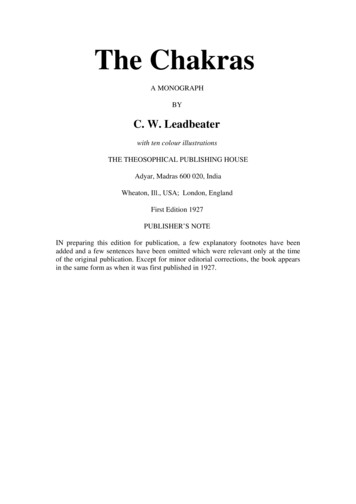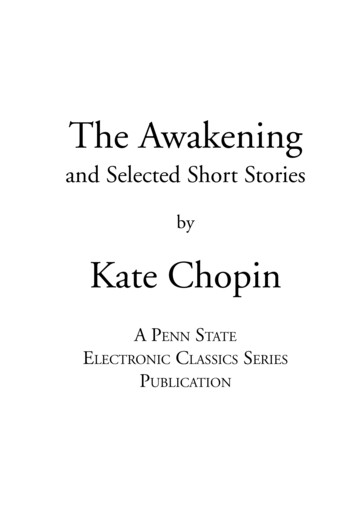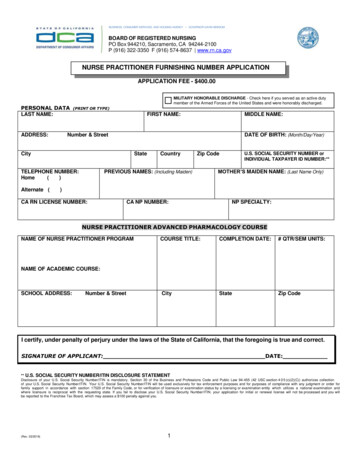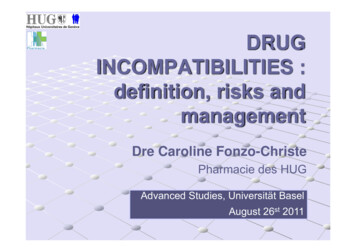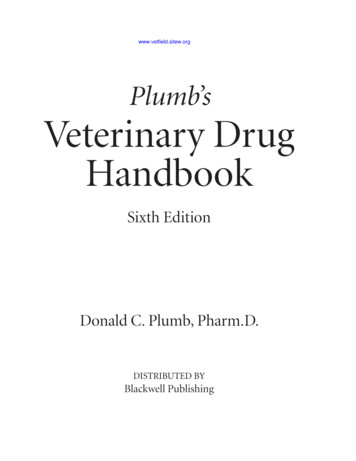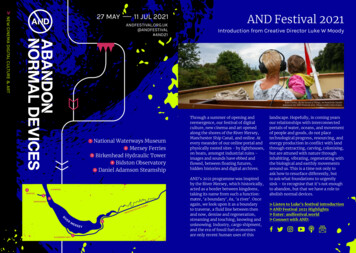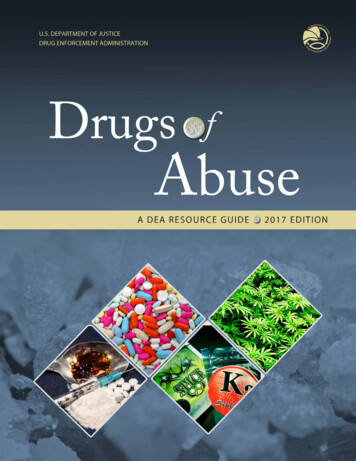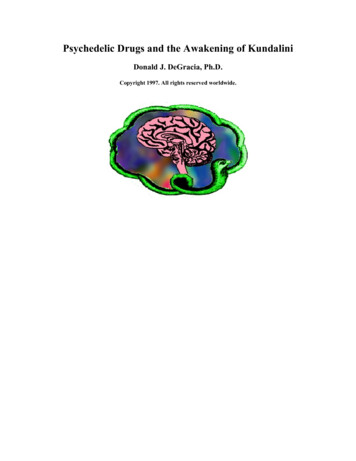
Transcription
Psychedelic Drugs and the Awakening of KundaliniDonald J. DeGracia, Ph.D.Copyright 1997. All rights reserved worldwide.
TABLE OF CONTENTSBackground Information About Psychedelic Drugs . 4About Kundalini. 10Summary of Effects of Awakened Kundalini. 14Introduction. 16Methods. 17Hallucinogenic Drug User Survey . 18Results: Overview. 22Detailed ResultsRespondent's Demographic Profile. 25Ss Hallucinogenic Usage . 27Ss Use of Other Drugs and Comparison to Hallucinogens. 30Motor and Autonomic Effects . 39Spontaneous Laughter. 42Auditory Hallucination Data. 43Sensations of Chills and Vibrations. 47Psychedelic Induced Synesthesia. 51Visual Hallucination - Text Responces. 55Visual Hallucination - Raw Data . 61Psychdelic Induced Emotional Changes. 64Psychdelic Induced Changes in Empathy . 69Psychdelic Induced Changes in Identity . 72Changes in Cognition: Concentration. 77Psychedelic Induced Changes in Thought . 82Long-term Effects of Psychedelics on Ss . 89Ss General Comments on Psychedelics . 95Psychedelic Drug-induced Religious and Psychic Experiences . 102Effects of Psychedelics on Ss Spirituality . 110Discussion . 1131. Numerical Data . 1152. Hallucinogenic Effects: Textual Analysis. . 1173. Implications of Sensory Alterations. 1254. Common Mechanisms?. 128Conclusion . 130A Depiction of a Visual Hallucination. 131Links to other sources of Information. 1332
IntroductionThe purpose of this document is to compare the effects of psychedelic drugs to the effects ofwhat is called in the Tantric and Occult literature "awakening of the kundalini".The comparison will be carried out in two ways. First, an abbreviated review of the literature onboth psychedelic drugs and kundalini awakening will be presented. When these two literaturesare placed side by side, it becomes much more apparent that there is a significant overlapbetween the effects of psychedelic drugs and the effects of awakened kundalini.Second, I will present results from a survey I performed designed to compare the effects ofpsychedelic drugs and kundalini awakening. The survey questioned psychedelic drug users aboutthe nature of their psychedelic drug experiences. The complete results of the survey arepresented in the Results Section of this site. It is very instructive to read the responces given tothe survey questions and recognize that descriptions of psychedelic drug experiences are, inmany respects, indistinquishable from reports of kundalini awakening.I invite any comments, questions and correspondence.Don DeGracia, Ph.D.April, 19973
Background Information About Psychedelic DrugsThe hallucinogens are a class of molecules which, when orally ingested, create tremendousalterations in human consciousness. Some members of this family of compounds include: dlysergic acid diethylamide (LSD), mescaline, psylocybin, peyote, and dimethyltryptamine(DMT). Most hallucinogens are naturally occurring substances which can be isolated frombiological sources[1] .Our present understanding of hallucinogenic drugs is both complicated and confusing. This isdue largely to the turbulent history of these drugs. Originally, they were greeted by thepsychological community as a means of chemically inducing schizophrenia [2], a notion that stillpersists (c.f. [3] ). During this initial period, these drugs were called "psychomimetic" drugs,indicating their presumed ability to induces psychosis. However, the writings of avante gardeintellectuals in the late 1950s and early 1960s painted a significantly different picture ofhallucinogens, seeing in them a key to expanded states of consciousness and leading toexperiences similar, if not identical to the teachings of ancient Eastern philosophy [4]. Duringthis era, these drugs became known as "psychedelic" which literally means "mind manifesting";in other words, the effects of psychedelics manifest through changes in the mind. Somepsychologists were beginning to accept such a viewpoint as further work on human subjectsprogressed, revealing flaws in the logic of the psychomimetic paradigm, while simultaneously,the therapeutic uses of hallucinogens in a number of clinical psychiatric settings showed greatpromise [5]. Such a view, coupled with broad, positive media exposure by Timothy Leary andothers led to a popular interest in hallucinogens in the mid to late 1960s, the so-called"psychedelic 60s", leading to wide spread use of hallucinogens. However, views of these drugsbecame ever more polarized as negative reports of LSD effects also emerged. Popular usage wasmet with alarmist reactions by mainstream medical and legal authorities due to exaggerated andunsubstantiated claims of dangers associated with LSD use [6]. By October of 1966, these drugswere made illegal in the United States. At present these drugs are still illegal in Westernindustrial nations and this has severely curtailed the scientific investigation of this class ofcompounds. According to Tart (1990), "basic research virtually stopped in this area in the early1960s" [7]. This is true regarding the effects of these drugs on humans. Some animal researchhas continued to the present on the pharmacology and neurophysiology of these drugs. However,as of 1994, there is some good news; the FDA has approved the use of psychedelics in twohuman studies: one characterizing the effects of DMT, the other characterizing the effects ofMDMA.There is today a large, complex, and often contradictory, literature on hallucinogenic drugs. Inthis article I will try only to present a brief and highly abbreviated overview of our currentknowledge about these compounds. There are two factors relevant to the current discussion: 1.conceptualizing the effects of hallucinogenic drugs and 2. understanding the mode of action ofhallucinogens on the central nervous system (CNS). In general, it is reasonable to say, based oncurrent evidence, that neither the effects of these drugs nor their mode of action has beensuccessfully characterized. Let us look at each in turn.The phenomenology of the hallucinogenic experience is extremely complex, operating, again, atphysiological, sensory, emotional, cognitive, and we could say, spiritual, levels. Hallucinogenic4
induced alterations are so drastic from our normal states of consciousness, that, again, we maycall the state induced by hallucinogens an ASC.The physiological effects of hallucinogenic induced ASC are reasonably straight-forward: pupilsdilate, heart rate increases, breathing patterns are altered, chills and tremors are experienced,spontaneous motor motions such as dance and gestures may result, and sleeping is significantlyimpaired. The controversy begins when we go beyond the obvious physiological symptoms ofthese drugs. At sensory, emotional and cognitive levels a wide variety of conflicting reportsexist. Perhaps the easiest way to conceptualize the variety of views of the effects ofhallucinogenic drugs is to realize that they lie along a spectrum.At one extreme of this spectrum, the effects of hallucinogens are viewed in a negative light andthought of as a neuropathology; sensory alterations are called 'hallucinations', emotional changesare seen to be related to paranoia and the disjointed behavior of schizophrenics, and cognitivealterations are considered to be delusions. Thus, to some, all alterations caused by hallucinogensare considered subnormal or pathological.At the opposite extreme of the spectrum, hallucinogenic effects are viewed in a positive light andassociated with super-normal alterations in sensory, emotional and cognitive effects. Thehallucinogen effects are associated with Eastern philosophy: LSD and related compounds caninduce mystical experiences. They also enhance creativity, enhance the operation of the mindand emotions, and produce effects highly therapeutic for the psychological growth of theindividual.All views of hallucinogenic effects fall somewhere on this spectrum. Some of the reasons behindsuch a seemingly disparate range of views on the nature of hallucinogenic induced ASC are: thediffering paradigms of various groups of researchers (i.e. psychomimetic verses psychedelic),different criteria used to define alterations in emotional or mental function, whether or not theresearchers themselves have actually used hallucinogenic drugs, and wider societal andphilosophic assumptions that affect researcher motives. Also, basic problems of scientificmethod come into question when attempting to ascertain hallucinogenic phenomenology. Yensen(1984) argues that because of the extreme effects of hallucinogens the standard double-blindprotocols used in assessing most drugs simply does not apply to hallucinogens [8] This isbecause the researcher will always know which group has been given hallucinogens because it isobvious as to which subjects are affected. This is in contrast to say, studies of a blood pressuremedication in which placebos and treatment groups cannot be distinguished by obvious means.So, being cognizant of the spectrum of views of hallucinogens, can we at least saliently outlinethe effects of these drugs on humans? Obviously we cannot, for any view we take will fallsomewhere on the above spectrum. It is inevitable that subjective value judgments enter into theassessment of the effects of hallucinogens. However, admitting to inevitable value judgments,some things can be stated.For one, these drugs do cause the perception of some type of visual imagery - hence the namehallucinogen. The imagery itself is very difficult to describe in words: often fantastic, intricatelybeautiful and highly dynamic images of highly colored geometric patterns are superimposed over5
one's vision, and such imagery becomes massively intensified when one closes their eyes (Clickhere to see an example). Such imagery also possess the property of "things within things withinthings" as found, for example, in a fractal [9]. Walls, floors and other objects appear to "breathe".One perceives "trails" on moving objects, which are similar to the appearance of motion under astroboscopic light. In spite of all these visual alterations, most of the time, the subject's normalvision still functions and these images are overlaid over the normal visual perceptions. Theremay be alterations in hearing and body sensations as well. In general, there is a heightening ofsensory perception which are overlaid with some type of new imagery (i.e. a "hallucination") notof sensory origin.At emotional and cognitive levels, hallucinogenic users become much more introspective andturned inwards on critical self-reflection. There may be loss of ego boundaries. Thoughts ofprofoundness and transcendence may occur. There is increased spontaneous free association,there may be either a lessening or heightening of concentration. There is a shift from logical,linear thinking to holistic intuitive thought. These are only some of the emotional and cognitiveeffects of hallucinogens.One would think that perhaps with a knowledge of the mode of action of hallucinogens, that thiswould clarify the nature of their effects. It is known that hallucinogens chemically resemblevarious neurotransmitters. For example, LSD resembles serotonin [10] (also called 5hydroxytryptamine [5-HT]) and mescaline resembles norepinephrine. Serotonin is an importantneurotransmitter in various brain regions, and its source comes from neurons located in the brainstem, in clusters of neurons called the raphe nuclei [11] . The raphe nuclei are known to play animportant role in regulating autonomic nervous system activity, regulating sleep-wake cycles,and states of arousal [12] . Evidence indicates that LSD alters serotonin neurotransmission, butthe details are complicated by the fact that there are several types of serotonin receptors and LSDinteracts differently with each. These serotonin receptors are distributed in a complex fashionthroughout the brain, further complicating our understanding. It is also known that LSD has aneffect on the pathways of nerve conduction of the eye. This is probably an indirect effect of LSD,mediated by its complex effects on neurotransmission in general. LSD decreases the response ofa visual relay center known as the lateral geniculate nucleus (LGN) located in the thalamus[13,14]. The retina of the eye sends its nerve impulses to the LGN. The LGN then relays itssignals to the occipital cortex which is also known as the primary visual cortex (also called Area17). What LSD does is decrease the responsiveness of the LGN to input from the retina. Otherhallucinogens affect the hypothalamus and its regulation of hormones [15] , or affect dopaminesytems [16] or the norepinephrine system of the locus coruleus [11].6
Now, how well do these actions help explain the effects of hallucinogens? The complex, andmostly unknown, effects on brainstem neurotransmission likely mediate both the physiologicaland psychological changes seen when on hallucinogens. However, hallucinogens that producevery similar psychological effects show significant differences in modes of action onneurotransmission, meaning that the neurochemistry of hallucinogenic effects is probablymediated through redundant and complex pathways. [17]. Regarding visual hallucinations,theories ranging from changes at the LGN to changes in the visual corticies have been proposed.In general, it is safe to say, and has been said quite recently[8,18], that the mode of action ofhallucinogens is still not understood. This is really no surprise when we consider 1. how complexare the systems being affected by hallucinogenic drugs, and 2. the function of the brain inmediating higher cognitive function is still incompletely understood. Since hallucinogens affecthigher cognitive functions so drastically, perhaps it is a case of putting the cart before the horseto expect our current knowledge of the action of these drugs to explain how they create cognitivealterations in humans. Quite the contrary, it seems very reasonable to suggest that anunderstanding of the mode of action of hallucinogens on higher cognitive function could revealmuch about the brain's role in cognition.In the Discussion section of this report I will offer some specualtions about the mode of action ofpsychedelic drugs in the human brain based on the profile of psychological effects of thesedrugs, taking into account some of the most recent findings about brain function and psychology.Finally, let us keep in mind that the purpose of this report is to suggest that psychedelic drugeffects are similar to the Tantric notion of awakened Kundalini. The main idea here being that aswe unravel the "hows" of psychedelic drugs, we may also be unraveling the "hows" behindKundalini Yoga.References for Psychedelic Section1. Smith MV, (1981). Psychedelic Chemistry. Loompanics Unlimited. Port Townsend,Washington.2. Bravo, G. and Grob, C. "Shamans, Sacraments, And Psychiatrists". Journal Of PsychoactiveDrugs. 21(1), Jan-Mar, 1989, 123-8.7
3. Vardy MM , Kay SR . LSD psychosis or LSD-induced schizophrenia? A multimethod inquiry.Archives of General Psychiatry :, 40(8):877-83, 1983 Aug.4. Watts, A. The Joyous Cosmology. New York: Vintage Books, 1962.Leary, T. "The Religious Experience: Its Production And Interpretation". Psychedelic Review. 1,1964, 324-46.Huxley A, The Doors of Perceptions. New York, Harper. 1954.5. See Part VII, Therapeautic Applications inAaronson, B., and Osmond, H. (Eds.). Psychedelics. New York: Doubleday & Co. Inc., 1970.6. Cohen MM, Shiloh Y. Genetic toxicology of lysergic acid diethylamide (LSD-25). [Review]In: 97, ed. Mutation Research :, 1977:Also see Stevens, J. Storming Heaven: LSD And The American Dream. New York: Harper &Row, 1988. that discusses the hisroy of this era.7. Tart C, (1990) Altered States of Consciousness, 3rd edition, Harper San Fransico. p 569.8. Yensen R. LSD and Psychotherapy. Journal of Psychoactive Drugs. 17(4):267-77, 1985 OctDec9. Alan Watts says this (see 4 above) about acid hallucinations which sounds very much like heis describing fractals. Furthermore, check out his connection between the images that one ispercieving and the idea that one may be actually watching their own brain at work:"Closed-eyed fantasies in this world (of ones hallucinations) seems sometimes to be revelationsof the secret workings of the brain, of the associative and patterning processes, the orderingsystems which carry out all our sensing and thinking. .they are for the most part ever morecomplex variations on a theme: ferns sprouting ferns sprouting ferns in multidimensional spaces,vast kaleidoscopic domes of stained glass or mosaic, or patterns like the models of highlyintricate molecules, systems of colored balls, each one of which turns out to be a multitude ofsmaller balls, forever and ever Is this perhaps, an inner view of the organizing process which,when our eyes are open, make sense of the world even at points where it appears to be supremelymessy?" (parenthesis mine)10. Pierce PA. Peroutka SJ. Antagonist properties of d-LSD at 5-hydroxytryptamine2 receptors.[Review] Neuropsychopharmacology. 3(5-6):503-8, 1990 Oct-Dec.11. McCallRB *. Neurophysiological effects of hallucinogens on serotonergic neuronal systems.In:. Neuroscience & Biobehavioral Reviews :, 1982:8
12. MorganePJ *, & SternWC *.The role of serotonin and norepinephrine in sleep-wakingactivity. National. Institute. on. Drug. Abuse:. Research. Monograph. Series. (3):37-6113. Ruch-Monachon MA. Jalfre M. Haefely W. Drugs and PGO waves in the lateral geniculatebody of the curarized cat. II. PGO wave activity and brain 5-hydroxytryptamine. ArchivesInternationales de Pharmacodynamie et de Therapie. 219(2):269-86, 1976 Feb.14. Williams JM. Distortions of vision and pain: two functional facets of D-lysergic aciddiethylamide. Perceptual & Motor Skills. 49(2):499-528, 1979 Oct.15. HorowskiR *, GrafKJ *. Neuroendocrine effects of neuropsychotropic drugs and theirpossible influence on toxic reactions in animals and man -- the role of the dopamine-prolactinsystem. In: Supplement, ed. Archives of Toxicology16. AhnHS *, MakmanMH *. Interaction of LSD and other hallucinogens with dopaminesensitive adenylate cyclase in primate brain: regional differences. In: 97, ed. Brain Research :,1979:17. Buckholtz NS. Zhou DF. Freedman DX. Potter WZ. Lysergic acid diethylamide (LSD)administration selectively downregulates serotonin2 receptors in rat brain.Neuropsychopharmacology. 3(2):137-48, 1990 Apr.18. Van Woerkom, A.E. "The Major Hallucinogens And The Central Cytoskeleton: AnAssociation Beyond Coincidence? Towards Subcellular Mechanisms In Schizophrenia". MedicalHypothesis. 31, 1990, 7-15.9
About KundaliniThe Caduceus is taken in Tantra as a symbol of the ethereal channels through which thekundalini ascends to the higher chakras.KundaliniThe phenomena of kundalini awakening is a concept derived from Tantric yoga and is part of arich theory describing what is usually termed the "human subtle anatomy". The idea of "subtleanatomy" is that there are aspects to human anatomy that are not physical and that cannot beperceived with the physical senses. Included here are ideas of chi and prana (also called "vitalenergy" or "etheric energy" by Western authors [1] ), meridians (which are the basis foracupuncture [2] ), nadis, chakras and kundalini. Kundalini is a component of the human subtleanatomy [3] . According to Tantric theory, and bodies of thought derived from it, there is withinthe subtle body, in a region corresponding to the base of the spine, a latent "energy" - thekundalini- that, when brought into manifestation confers both enlightenment (i.e. mysticalexperience) and a variety of psychic powers to the aspirant [4] .The idea of kundalini is almost always discussed in the context of the chakra system. Thechakras are revolving vortexes, depicted as flower-like in appearance, at specific locations alongthe spinal axis within the subtle body [2,4]. For our purposes here it is enough to say thatawakening of the kundalini means the progressive ascent of the kundalini through each of thechakras, heightening the activity of that chakra and conferring expanded abilities (i.e. psychicpowers and states of health) associated with that chakra. The topic of the chakras, theirdescription, anatomy and functions is complex and the interested reader can consult a number ofvaluable references on chakras and kundalini [1-4] for further information.10
The manifestation of the kundalini is called the "awakening" of the kundalini to stress that it islatent and must be made active. The traditional means by which kundalini is awakened involve avariety of yoga exercises passed down through the centuries including specific breath exercisesand purificatory rites [5, 6]. However, it is also known that acts such as falling or getting hit onthe head may trigger spontaneous kundalini awakening [4], and as well, certain drugs are knownto mimic aspects of the kundalini experience [4]. This idea that drugs may mimic kundalini is ofcourse the central thesis of this report.The phenomenology of awakened kundalini is listed in Table 1: Effects of Kundalini [based onWhite (1990) and Mookerjee (1986)]. Kundalini awakening encompasses the whole gamut ofpersonal human experience: there are alterations at physiological, sensory, emotional, cognitiveand spiritual levels. The changes produced by awakened kundalini are so drastic from our usualstates of consciousness that it is reasonable to say that a person undergoing awakened kundaliniis experiencing an altered state of consciousness (ASC). The person is undergoing a variety ofphysiological alterations including sensations of shivers or tremors moving up and down thespine, displaying spontaneous motor movements in the form of dance, hand gestures, or asañas(sitting postures practiced in Hatha yoga), experiencing spontaneous alterations in breathing,may spontaneously cry or laugh (usually unassociated with emotional reactions) and is alsoexperiencing alterations in perception of body temperature. At the sensory level, both audio andvisual hallucinations or visions are prominent including visions of extremely beautiful anddynamically moving geometrical figures. Also, kinesthetic and somesthetic sensations (i.e.sensations of body motion and body position, respectively) may be altered such that the personperceives themself as very large or very small. Emotionally, the person is experiencing extremesof emotions: usually either pure bliss and ecstasy or extreme fear. Empathy with others issubstantially enhanced. Drastic cognitive alterations also occur. The mind and thought processaccelerate greatly, the scope and depth of the thought process expand tremendously and evenordinary objects and events are perceived to have tremendous scope and consequences. Directintuition completely supersedes ordinary logical thinking and questions that come into the mindare directly answered with clarity and conviction through heightened intuitive processes. Aswell, a variety of psychic powers may potentially manifest including visions of past lives,clairvoyant visions (which could be classified as visual hallucinations), and clairaudience (audiohallucinations), amongst others.Finally, the supreme manifestation of kundalini awakening, and the formal and proper goal of thepractices leading to kundalini awakening, is the experience of enlightenment, also called satori,cosmic consciousness, or the mystical experience. Enlightenment is a direct apprehension of theunity of the cosmos, a direct apprehension and identification with the transcendental essence oflife and consciousness. Its essence is a "direct knowing" and a clear comprehension into "thescheme of things". Enlightenment has been an aspect of Eastern religious thought since thebeginning of known history and plays as central a role in Tantric theory as it does in any otheraspect of Eastern thought.The list in the Table: Effects of Kundalini presents a broad overview, or composite, of thephenomenology associated with kundalini awakening. It is important to point out that not all ofthese effects will necessarily be experienced by one undergoing kundalini awakening, and that11
the effects that do manifest are highly dependant on the internal psychological and emotionalneeds of the individual.It is clear that the awakening of the kundalini is not a series of a few small alterations inconsciousness, but involves a global transformation of the entire person. The resulting state maybe properly called one of hyper-awareness. As such, the fact that the kundalini experience existsat all indicates that we are dealing with an emergent property, or quality of consciousness, thatresults from a hyper-activation of all the systems of the body and mind. This is not a statefamiliar to most people. It is not even a state familiar to most people who practice kundaliniyoga. We are thus dealing with an altered state of consciousness that occurs relativelyinfrequently. The implication here is that, if indeed the kundalini experience is a hyperactivestate of awareness, then we cannot rightly judge it by criteria used to ascertain our normal andusual states of awareness. In other words, to attempt to understand the kundalini experience, weare forced to go beyond our ordinary notions of consciousness and human nature. If we do not,then we miss the most significant aspects of the kundalini phenomena.It should be explicitly stated that the stages leading up to kundalini awakening, as well as theexperience itself, may potentially be very painful and even harmful to the individual. All texts onkundalini yoga warn of these dangers [3-6]. The purificatory rites and practices are considered anessential aspect of kundalini yoga and cannot be lightly dismissed. The logic of Tantra is that thebody, emotions and mind must be properly purified before attempting to awaken the kundalini,for if not, the unpurified body and mind of the person present obstacles to the kundalini itselfwhen it is awakened. The kundalini however will "burn" through these obstacles if present andcause severe pain to the individual at either physical, emotional or cognitive levels. Thus, asenticing as the kundalini experience may sound, it is not something one can casually seek outunless the necessary preparation is undertaken, or unless one decides beforehand to be preparedto suffer the consequences that may come with attempting to tap into the kundalini. As we willsee below in tying together kundalini with hallucinogenic drug effects, such consequencesusually manifest as the exposure of deep seated emotional scars and the psychologicalcatastrophe of having ones cherished beliefs destroyed before oneself , and possibly, thedestruction on one's sense of self (ego loss). In all of these cases, the circumstance is catharticand related to the kundalini burning away unneces
both psychedelic drugs and kundalini awakening will be presented. When these two literatures are placed side by side, it becomes much more apparent that there is a significant overlap between the effects of psychedelic drug
